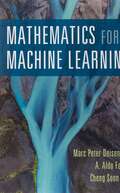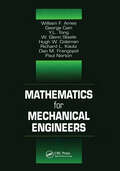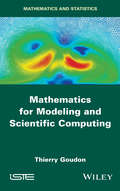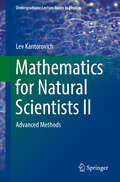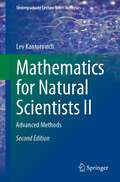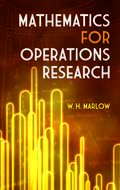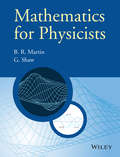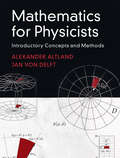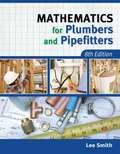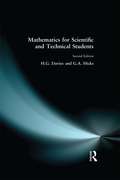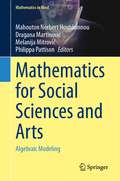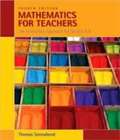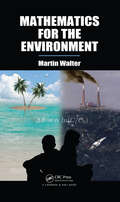- Table View
- List View
Mathematics for Everyman: From Simple Numbers to the Calculus
by Egmont ColerusMany people suffer from an inferiority complex where mathematics is concerned, regarding figures and equations with a fear based on bewilderment and inexperience. This book dispels some of the subject's alarming aspects, starting at the very beginning and assuming no mathematical education.Written in a witty and engaging style, the text contains an illustrative example for every point, as well as absorbing glimpses into mathematical history and philosophy. Topics include the system of tens and other number systems; symbols and commands; first steps in algebra and algebraic notation; common fractions and equations; irrational numbers; algebraic functions; analytical geometry; differentials and integrals; the binomial theorem; maxima and minima; logarithms; and much more. Upon reaching the conclusion, readers will possess the fundamentals of mathematical operations, and will undoubtedly appreciate the compelling magic behind a subject they once dreaded.
Mathematics for Health Sciences: A Comprehensive Approach
by Joel HelmsSelect topics according to your mathematical ability and chosen healthcare profession. Begin with a basic math review or move right to deeper concepts, including algebra and geometry, linear equations and graphing, dilutions, solutions, concentrations, dosage calculations, and more! Learn at your own pace with this easy-to-use math text specifically for the health sciences.
Mathematics for Human Flourishing
by Francis SuAn inclusive vision of mathematics—its beauty, its humanity, and its power to build virtues that help us all flourish For mathematician Francis Su, a society without mathematical affection is like a city without concerts, parks, or museums. To miss out on mathematics is to live without experiencing some of humanity&’s most beautiful ideas. In this profound book, written for a wide audience but especially for those disenchanted by their past experiences, an award‑winning mathematician and educator weaves parables, puzzles, and personal reflections to show how mathematics meets basic human desires—such as for play, beauty, freedom, justice, and love—and cultivates virtues essential for human flourishing. These desires and virtues, and the stories told here, reveal how mathematics is intimately tied to being human. Some lessons emerge from those who have struggled, including philosopher Simone Weil, whose own mathematical contributions were overshadowed by her brother&’s, and Christopher Jackson, who discovered mathematics as an inmate in a federal prison. Christopher&’s letters to the author appear throughout the book and show how this intellectual pursuit can—and must—be open to all.
Mathematics for Large Scale Computing (Lecture Notes In Pure And Applied Mathematics Ser.)
by J. C. DíAZDuring recent years a great deal of interest has been devoted to large scale computing applications. This has occurred in great part because of the introduction of advanced high performance computer architectures. The book contains survey articles as well as chapters on specific research applications, development and analysis of numerical algorithms, and performance evaluation of algorithms on advanced architectures. The effect of specialized architectural features on the performance of large scale computation is also considered by several authors. Several areas of applications are represented, including the numerical solution of partial differential equations, iterative techniques for large structured problems, the numerical solution of boundary value problems for ordinary differential equations, numerical optimization, and numerical quadrature. Mathematical issues in computer architecture are also presented, including the description of grey codes for generalized hypercubes. The results presented in this volume give, in our opinion, a representative picture of today’s state of the art in several aspects of large scale computing.
Mathematics for Machine Learning
by Marc Peter Deisenroth A. Aldo Faisal Cheng Soon OngThe fundamental mathematical tools needed to understand machine learning include linear algebra, analytic geometry, matrix decompositions, vector calculus, optimization, probability and statistics. These topics are traditionally taught in disparate courses, making it hard for data science or computer science students, or professionals, to efficiently learn the mathematics. <p><p>This self contained textbook bridges the gap between mathematical and machine learning texts, introducing the mathematical concepts with a minimum of prerequisites. It uses these concepts to derive four central machine learning methods: linear regression, principal component analysis, Gaussian mixture models and support vector machines. For students and others with a mathematical background, these derivations provide a starting point to machine learning texts. <P><p>For those learning the mathematics for the first time, the methods help build intuition and practical experience with applying mathematical concepts. Every chapter includes worked examples and exercises to test understanding. Programming tutorials are offered on the book's web site.
Mathematics for Mechanical Engineers
by Frank Kreith Hugh W. Coleman W. Glenn Steele George Cain Dan M. Frangopol Paul Norton William F. Ames Y. L. Tong Richard L. KautzMathematics for Mechanical Engineers gives mechanical engineers convenient access to the essential problem solving tools that they use each day. It covers applications employed in many different facets of mechanical engineering, from basic through advanced, to ensure that you will easily find answers you need in this handy guide.For the engineer venturing out of familiar territory, the chapters cover fundamentals like physical constants, derivatives, integrals, Fourier transforms, Bessel functions, and Legendre functions. For the experts, it includes thorough sections on the more advanced topics of partial differential equations, approximation methods, and numerical methods, often used in applications. The guide reviews statistics for analyzing engineering data and making inferences, so professionals can extract useful information even with the presence of randomness and uncertainty. The convenient Mathematics for Mechanical Engineers is an indispensable summary of mathematics processes needed by engineers.
Mathematics for Modeling and Scientific Computing
by Thierry GoudonThis book provides the mathematical basis for investigating numerically equations from physics, life sciences or engineering. Tools for analysis and algorithms are confronted to a large set of relevant examples that show the difficulties and the limitations of the most naïve approaches. These examples not only provide the opportunity to put into practice mathematical statements, but modeling issues are also addressed in detail, through the mathematical perspective.
Mathematics for Natural Scientists
by Lev KantorovichThis book covers a course of mathematics designed primarily for physics and engineering students. It includes all the essential material on mathematical methods, presented in a form accessible to physics students, avoiding precise mathematical jargon and proofs which are comprehensible only to mathematicians. Instead, all proofs are given in a form that is clear and convincing enough for a physicist. Examples, where appropriate, are given from physics contexts. Both solved and unsolved problems are provided in each section of the book. Mathematics for Natural Scientists: Fundamentals and Basics is the first of two volumes. Advanced topics and their applications in physics are covered in the second volume.
Mathematics for Natural Scientists II
by Lev KantorovichThis book covers the advanced mathematical techniques useful for physics and engineering students, presented in a form accessible to physics students, avoiding precise mathematical jargon and laborious proofs. Instead, all proofs are given in a simplified form that is clear and convincing for a physicist. Examples, where appropriate, are given from physics contexts. Both solved and unsolved problems are provided in each chapter. Mathematics for Natural Scientists II: Advanced Methods is the second of two volumes. It follows the first volume on Fundamentals and Basics.
Mathematics for Natural Scientists II: Advanced Methods (Undergraduate Lecture Notes in Physics)
by Lev KantorovichThis textbook, the second in a series (the first covered fundamentals and basics), seeks to make its material accessible to physics students. Physics/engineering can be greatly enhanced by knowledge of advanced mathematical techniques, but the math-specific jargon and laborious proofs can be off-putting to students not well versed in abstract math. This book uses examples and proofs designed to be clear and convincing from the context of physics, as well as providing a large number of both solved and unsolved problems in each chapter. This is the second edition, and it has been significantly revised and enlarged, with Chapters 1 (on linear algebra) and 2 (on the calculus of complex numbers and functions) having been particularly expanded. The enhanced topics throughout the book include: vector spaces, general (non-Hermitian, including normal and defective) matrices and their right/left eigenvectors/values, Jordan form, pseudoinverse, linearsystems of differential equations, Gaussian elimination, fundamental theorem of algebra, convergence of a Fourie series and Gibbs-Wilbraham phenomenon, careful derivation of the Fourier integral and of the inverse Laplace transform. New material has been added on many physics topics meant to illustrate the maths, such as 3D rotation, properties of the free electron gas, van Hove singularities, and methods for both solving PDEs with a Fourier transform and calculating the width of a domain wall in a ferromagnet, to mention just a few. This textbook should prove invaluable to all of those with an interest in physics/engineering who have previously experienced difficulty processing the math involved.
Mathematics for New Technologies
by Don Hutchison Mark YannottaThis text addresses the need for a new mathematics text for careers using digital technology. The material is brought to life through several applications including the mathematics of screen and printer displays. The course, which covers binary arithmetic to Boolean algebra, is emerging throughout the country and may fill a need at your school. This unique text teaches topics such as binary fractions, hexadecimal numbers, and Venn diagrams to students with only a beginning algebra background.
Mathematics for Operations Research
by W. H. MarlowThis practical, applications-oriented text demonstrates the key role of mathematics in optimization and linear systems. It explains effective procedures for performing mathematical tasks that arise in many fields, including operations research, engineering, systems sciences, statistics, and economics. Readers will learn how to resolve linear independence and find null spaces and factors of matrices, determine existence of restricted solutions to linear equations and inequalities, and resolve definiteness of Hermitian and real symmetric matrices by Gaussian pivoting. Additional topics include how to diagonalize — or "nearly" diagonalize — square matrices, differentiate vectors and matrices by the chain rule, solve systems of differential and difference equations, and other subjects. Most of the examples and many of the 1,300 problems illustrate techniques, and nearly all of the tables display reference material for procedures. Differential and integral calculus are prerequisites.
Mathematics for Physicists
by Brian R. Martin Graham P. ShawMathematics for Physicists is a relatively short volume covering all the essential mathematics needed for a typical first degree in physics, from a starting point that is compatible with modern school mathematics syllabuses. Early chapters deliberately overlap with senior school mathematics, to a degree that will depend on the background of the individual reader, who may quickly skip over those topics with which he or she is already familiar. The rest of the book covers the mathematics that is usually compulsory for all students in their first two years of a typical university physics degree, plus a little more. There are worked examples throughout the text, and chapter-end problem sets. Mathematics for Physicists features: Interfaces with modern school mathematics syllabuses All topics usually taught in the first two years of a physics degree Worked examples throughout Problems in every chapter, with answers to selected questions at the end of the book and full solutions on a website This text will be an excellent resource for undergraduate students in physics and a quick reference guide for more advanced students, as well as being appropriate for students in other physical sciences, such as astronomy, chemistry and earth sciences.
Mathematics for Physicists: Introductory Concepts and Methods
by Alexander Altland Jan Von DelftThis textbook is a comprehensive introduction to the key disciplines of mathematics - linear algebra, calculus, and geometry - needed in the undergraduate physics curriculum. Its leitmotiv is that success in learning these subjects depends on a good balance between theory and practice. Reflecting this belief, mathematical foundations are explained in pedagogical depth, and computational methods are introduced from a physicist's perspective and in a timely manner. This original approach presents concepts and methods as inseparable entities, facilitating in-depth understanding and making even advanced mathematics tangible. The book guides the reader from high-school level to advanced subjects such as tensor algebra, complex functions, and differential geometry. It contains numerous worked examples, info sections providing context, biographical boxes, several detailed case studies, over 300 problems, and fully worked solutions for all odd-numbered problems. An online solutions manual for all even-numbered problems will be made available to instructors.
Mathematics for Physics
by Michael Stone Paul GoldbartAn engagingly-written account of mathematical tools and ideas, this book provides a graduate-level introduction to the mathematics used in research in physics. The first half of the book focuses on the traditional mathematical methods of physics - differential and integral equations, Fourier series and the calculus of variations. The second half contains an introduction to more advanced subjects, including differential geometry, topology and complex variables. The authors' exposition avoids excess rigor whilst explaining subtle but important points often glossed over in more elementary texts. The topics are illustrated at every stage by carefully chosen examples, exercises and problems drawn from realistic physics settings. These make it useful both as a textbook in advanced courses and for self-study.
Mathematics for Plumbers and Pipefitters
by Lee SmithNow in its 8th edition, MATHEMATICS FOR PLUMBERS AND PIPEFITTERS delivers the essential math skills necessary in the plumbing and pipefitting professions. Starting with a thorough math review to ensure a solid foundation, the book progresses into specific on-the-job applications, such as pipe length calculations, sheet metal work, and the builder's level. Broad-based subjects like physics, volume, pressures, and capacities round out your knowledge, while a new chapter on the business of plumbing invites you to consider an exciting entrepreneurial venture. Written by a Master Plumber and experienced vocational educator, MATHEMATICS FOR PLUMBERS AND PIPEFITTERS, 8th Edition includes a multitude of real-world examples, reference tables, and formulas to help you build a rewarding career in the plumbing and pipefitting trade.
Mathematics for Scientific and Technical Students
by H. Davies H. G. Davies G. A. HicksThis new edition provides a full introduction to the mathematics required for all technical subjects, particularly engineering. It has been completely updated and is designed to bring the student up to the required mathematical knowledge for their course.
Mathematics for Social Sciences and Arts: Algebraic Modeling (Mathematics in Mind)
by Dragana Martinovic Mahouton Norbert Hounkonnou Melanija Mitrović Philippa PattisonThis book addresses interconnections between contemporary advances in mathematics, especially algebra, with applications in the social sciences and the arts. It promotes the idea that knowledge cannot remain in disciplinary silos, rather, it belongs to all people, and is dedicated to associative relationships in a variety of mathematics applications, from sociology to linguistics, including anthropology, semiotics, education, and cognitive science. Contributions illuminate some of the ways in which algebra is developed, learned, understood, communicated, and applied in the social sciences and the humanities.The content in this book has its origins in a conference, Mathematics for Social Sciences and Arts–Algebraic Modelling, virtually hosted by the Faculty of Mechanical Engineering, University of Niš, Serbia, from the 24th to the 26th of May, 2021. This conference brought together scholars from various disciplines and geographic regions and focused on the juxtaposition of algebra and social science applications. The conference organizers, higher education institutes from four different continents, invited leading scientists in social sciences and algebra, to contribute to this volume.The first part of this book addresses algebraic and mathematical thinking, specifically learning and practicing mathematics from a cognitive science perspective, as well as illustrative applications to distinctly human concerns, like education and semiotics. The second part focuses on algebraic semigroups and some of their generalizations. This book and the conference that engendered it provide an example of a fruitful collaboration, in which the skills and deep knowledge of algebraic structures, modeling, social sciences and arts brought in by the authors from different countries and continents merge in harmonious ways. These expositions are a rich resource and are of interest both to mathematicians and non-mathematicians.
Mathematics for Social Scientists: Learning Essential Foundational Skills
by Shobha Bagai Amber Habib Geetha VenkataramanThis book helps readers bridge the gap between school-level mathematical skills and the quantitative and analytical skills required at the professional level. It presents basic mathematical concepts in an everyday context, enabling readers to pick up skills with ease.Mathematics for Social Scientists:• Focuses on building foundational skills in reasoning, data analysis and quantitative methods that are a requisite for progressing to higher levels;• Helps readers express mathematical ideas in the form of sets, analyse arguments and their validity mathematically, interpret and handle data, and understand the concept and use of probability;• Includes a dedicated chapter on symmetry, perspective and art to encourage readers to reason, model and objectively evaluate everyday situations.The volume will be useful to students of various disciplines in Social Sciences and Liberal Arts. It will also be an invaluable companion to practitioners of social sciences, humanities and life sciences, as well as schoolteachers at the middle and higher secondary level.
Mathematics for Sustainable Industry: ISMI 2024, Kuala Lumpur, Malaysia, September 9–11 (Springer Proceedings in Mathematics & Statistics #496)
by Ahmad Fadillah Embong Zaitul Marlizawati Zainuddin Ani Shabri Fatin Nadiah Mohamed YussofThis volume gathers selected, peer-reviewed contributions presented at the 5th International Seminar on Mathematics in Industry – ISMI2024, held on September 9-11, 2024 in Kuala Lumpur, Malaysia. Articles in this volume touch on fields such as applied mathematics, applied probability theory and stochastic modeling, statistical modeling, operations research, biomathematics, optimization, inventory management, supply chain, and computational mathematics, all with an emphasis on solutions to real-world problems. Many of the studies contained here closely relate to the United Nations&’ Sustainable Development Goals, namely SDG 9 (Industry) and SDG 3 (Health), potentially inspiring practitioners and scholars to deploy these findings and pursue similar avenues of research. Since its inception in 2013, ISMI has been organized by the Centre for Industrial and Applied Mathematics (UTM-CIAM) and the Department of Mathematical Sciences, Universiti Teknologi Malaysia (UTM) with the aims of disseminating knowledge, sharing experiences in research on various aspects of industrial mathematics and statistics and fostering collaboration among academia, government agencies, industry, and community.
Mathematics for Teachers: An Interactive Approach for Grade K-8
by Thomas SonnabendMathematics for Teachers: An Interactive Approach for Grades K-8 actively involves students in developing and explaining mathematical concepts and how the topics relate to NCTM Standards and Curriculum focal points. The text includes coverage of reasoning, sets, arithmetic, geometry, measurement, algebra, statistics, and probability. The carefully organized, interactive lesson format promotes student involvement and gradually leads the student to a deeper understanding of mathematical ideas.
Mathematics for Veterinary Medical Technicians (Third Edition)
by Edward M. Stumpf Frederick R. Fritz William W. BradfordThe text provides a one-semester course in the basics of mathematics needed for Veterinary Technicians and Assistants.
Mathematics for economics and finance
by Martin Anthony Norman BiggsMathematics has become indispensable in the modelling of economics, finance, business and management. Without expecting any particular background of the reader, this book covers the following mathematical topics, with frequent reference to applications in economics and finance: functions, graphs and equations, recurrences (difference equations), differentiation, exponentials and logarithms, optimisation, partial differentiation, optimisation in several variables, vectors and matrices, linear equations, Lagrange multipliers, integration, first-order and second-order differential equations. The stress is on the relation of maths to economics, and this is illustrated with copious examples and exercises to foster depth of understanding. Each chapter has three parts: the main text, a section of further worked examples and a summary of the chapter together with a selection of problems for the reader to attempt. For students of economics, mathematics, or both, this book provides an introduction to mathematical methods in economics and finance that will be welcomed for its clarity and breadth.
Mathematics for the Environment
by Martin WalterMathematics for the Environment shows how to employ simple mathematical tools, such as arithmetic, to uncover fundamental conflicts between the logic of human civilization and the logic of Nature. These tools can then be used to understand and effectively deal with economic, environmental, and social issues. With elementary mathematics, the book se
Mathematics for the General Reader (Dover Books on Mathematics)
by E. C. TitchmarshThis highly accessible introduction to mathematics is geared toward readers seeking a firm grasp of the essentials of mathematical theory and practice. The treatment also offers a concise outline of mathematical history and a clearer notion of why mathematicians do what they do.Author E. C. Titchmarsh, who served for many years as Savilian Professor of Geometry at Oxford University, begins with counting and the fundamentals of arithmetic. He guides readers through the complexities of algebra, fractions, geometry, irrational numbers, logarithms, infinite series, complex numbers, quadratic equations, trigonometry, functions, and integral and differential calculus. Titchmarsh's graceful, fluid style helps make complicated topics easier to grasp, and his inclusion of numerous examples will prove especially helpful to readers with little or no background in mathematics.




